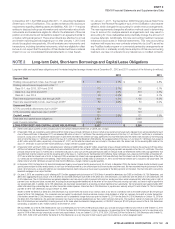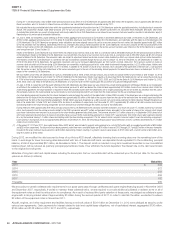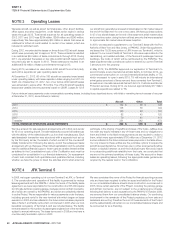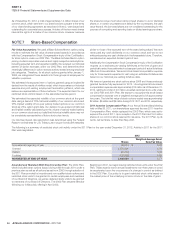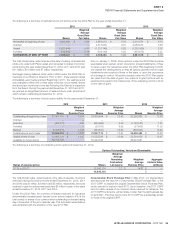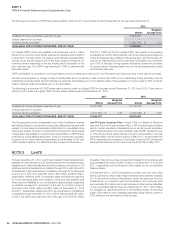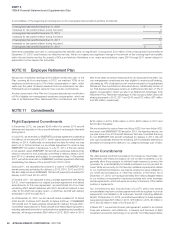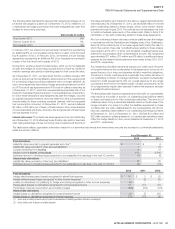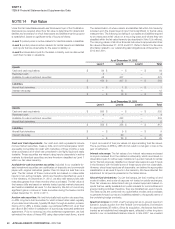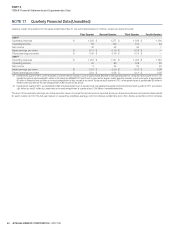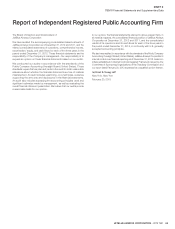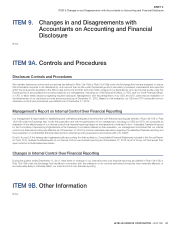JetBlue Airlines 2012 Annual Report Download - page 61
Download and view the complete annual report
Please find page 61 of the 2012 JetBlue Airlines annual report below. You can navigate through the pages in the report by either clicking on the pages listed below, or by using the keyword search tool below to find specific information within the annual report.
JETBLUE AIRWAYS CORPORATION-2012 10K 57
PART II
ITEM 8Financial Statements and Supplementary Data
NOTE 9 Income Taxes
The provision for income taxes consisted of the following for the years ended December31 (in millions):
2012 2011 2010
Deferred:
Federal $ 68 $ 51 $ 55
State 8 7 7
Deferred income tax expense 76 58 62
Current income tax expense 5 1 2
TOTAL INCOME TAX EXPENSE $ 81 $ 59 $ 64
The effective tax rate on income before income taxes differed from the federal income tax statutory rate for the years ended December31 for the
following reasons (in millions):
2012 2011 2010
Income tax expense at statutory rate $ 73 $ 51 $ 57
Increase (decrease) resulting from:
State income tax, net of federal benefi t 6 5 6
Valuation allowance — — (2)
Other, net 2 3 3
TOTAL INCOME TAX EXPENSE $ 81 $ 59 $ 64
Cash payments for income taxes were $4 million in 2012, zero in 2011 and $1 million in 2010.
The net deferred taxes below include a current net deferred tax asset of $107 million and a long-term net deferred tax liability of $481 million at
December31, 2012, and a current net deferred tax asset of $99 million and a long-term net deferred tax liability of $392 million at December31, 2011.
The components of our deferred tax assets and liabilities as of December31 are as follows (in millions):
2012 2011
Deferred tax assets:
Net operating loss carryforwards $ 127 $ 175
Employee benefi ts 36 37
Deferred revenue/gains 82 76
Rent expense 22 20
Terminal 5 lease 26 22
Capital loss carryforwards 20 20
Other 37 38
Valuation allowance (20) (21)
Deferred tax assets 330 367
Deferred tax liabilities:
Accelerated depreciation (704) (660)
Deferred tax liabilities (704) (660)
NET DEFERRED TAX LIABILITY $ (374) $ (293)
Rent expense had previously been included in deferred revenue/gains.
Terminal 5 lease was previously included with accelerated depreciation
and deferred revenue/gains.
At December31, 2012, we had U.S. Federal regular and alternative
minimum tax net operating loss (“NOL”) carryforwards of $371 million
and $343 million, respectively, which begin to expire in 2025. In addition,
at December31, 2012, we had deferred tax assets associated with state
NOLs of $9 million, which begin to expire in 2014. Our NOL carryforwards
at December31, 2012 include an unrecorded benefi t of approximately
$9 million related to stock-based compensation that will be recorded
in equity when, and to the extent, realized. Section382 of the Internal
Revenue Code imposes limitations on a corporation’s ability to use its NOL
carryforwards if it experiences an “ownership change.” As of December31,
2012, our valuation allowance did not include any amounts attributable
to this limitation; however, if an “ownership change” were to occur in the
future, the ability to use our NOLs could be limited.
In evaluating the realizability of the deferred tax assets, we assess whether
it is more likely than not that some portion, or all, of the deferred tax assets,
will be realized. We consider, among other things, the generation of future
taxable income (including reversals of deferred tax liabilities) during the
periods in which the related temporary differences will become deductible.
At December31, 2012, we provided a $20 million valuation allowance to
reduce the deferred tax assets to an amount that we consider is more likely
than not to be realized. Our valuation allowance at December31, 2012
is related to capital loss carryforwards which expire in 2015 and 2016.




